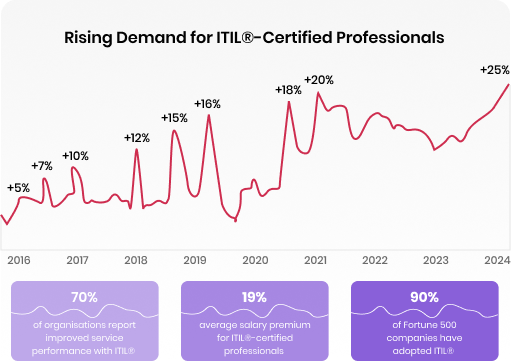ITIL® Practitioner Level
ITIL® Practitioner Level Courses build on foundational knowledge, focusing on applying ITIL® concepts in real-world scenarios. They equip professionals with practical tools for continual service improvement, stakeholder communication, and change adoption. It’s the essential next step for enhancing IT service delivery skills.
Browse Courses
ITIL® Practitioner
Duration: 2 Days

- Buxton
- Corby
- Derby
- Hinckley
- Leicester
- Lincoln
- Northampton
- Nottingham
- Birmingham
- Burton Upon Trent
- Coventry
- Solihull
- Stoke-on-Trent
- Warwick
- Wolverhampton
- Worcester
- Darlington
- Middlesbrough
- Newcastle
- Sunderland
- Carlisle
- Doncaster
- Harrogate
- Kingston upon Hull
- Leeds
- Sheffield
- Wakefield
- York
- Teesside
- Bath
- Bristol
- Cirencester
- Exeter
- Gloucester
- Plymouth
- Swindon
- Bournemouth
- Poole
- Brighton
- Canterbury
- Chatham
- Chichester
- Maidstone
- Portsmouth
- Southampton
- Tonbridge
- Jersey
- Bedford
- Luton
- Watford
- Bromley
- London
- Bracknell
- Milton Keynes
- Fleet
- Guildford
- High Wycombe
- Oxford
- Reading
- Slough
- Windsor Town
- Wokingham
- Gatwick
- Virtuals
- Heathrow
- Cambridge
- Chelmsford
- Colchester
- Ipswich
- Norwich
- Peterborough
- Bolton
- Chester
- Chorley
- Crewe
- Liverpool
- Manchester
- Preston
- Warrington
- Aberdeen
- Dundee
- Dunfermline
- Edinburgh
- Glasgow
- Inverness
- Cardiff
- Swansea
- Wrexham
- Belfast
- Dublin
- Buxton
- Corby
- Derby
- Hinckley
- Leicester
- Lincoln
- Northampton
- Nottingham
- Birmingham
- Burton Upon Trent
- Coventry
- Solihull
- Stoke-on-Trent
- Warwick
- Wolverhampton
- Worcester
- Darlington
- Middlesbrough
- Newcastle
- Sunderland
- Carlisle
- Doncaster
- Harrogate
- Kingston upon Hull
- Leeds
- Sheffield
- Wakefield
- York
- Teesside
- Bath
- Bristol
- Cirencester
- Exeter
- Gloucester
- Plymouth
- Swindon
- Bournemouth
- Poole
- Brighton
- Canterbury
- Chatham
- Chichester
- Maidstone
- Portsmouth
- Southampton
- Tonbridge
- Jersey
- Bedford
- Luton
- Watford
- Bromley
- London
- Bracknell
- Milton Keynes
- Fleet
- Guildford
- High Wycombe
- Oxford
- Reading
- Slough
- Windsor Town
- Wokingham
- Gatwick
- Virtuals
- Heathrow
- Cambridge
- Chelmsford
- Colchester
- Ipswich
- Norwich
- Peterborough
- Bolton
- Chester
- Chorley
- Crewe
- Liverpool
- Manchester
- Preston
- Warrington
- Aberdeen
- Dundee
- Dunfermline
- Edinburgh
- Glasgow
- Inverness
- Cardiff
- Swansea
- Wrexham
- Belfast
- Dublin
- Buxton
- Corby
- Derby
- Hinckley
- Leicester
- Lincoln
- Northampton
- Nottingham
- Birmingham
- Burton Upon Trent
- Coventry
- Solihull
- Stoke-on-Trent
- Warwick
- Wolverhampton
- Worcester
- Darlington
- Middlesbrough
- Newcastle
- Sunderland
- Carlisle
- Doncaster
- Harrogate
- Kingston upon Hull
- Leeds
- Sheffield
- Wakefield
- York
- Teesside
- Bath
- Bristol
- Cirencester
- Exeter
- Gloucester
- Plymouth
- Swindon
- Bournemouth
- Poole
- Brighton
- Canterbury
- Chatham
- Chichester
- Maidstone
- Portsmouth
- Southampton
- Tonbridge
- Jersey
- Bedford
- Luton
- Watford
- Bromley
- London
- Bracknell
- Milton Keynes
- Fleet
- Guildford
- High Wycombe
- Oxford
- Reading
- Slough
- Windsor Town
- Wokingham
- Gatwick
- Virtuals
- Heathrow
- Cambridge
- Chelmsford
- Colchester
- Ipswich
- Norwich
- Peterborough
- Bolton
- Chester
- Chorley
- Crewe
- Liverpool
- Manchester
- Preston
- Warrington
- Aberdeen
- Dundee
- Dunfermline
- Edinburgh
- Glasgow
- Inverness
- Cardiff
- Swansea
- Wrexham
- Belfast
- Dublin
- Buxton
- Corby
- Derby
- Hinckley
- Leicester
- Lincoln
- Northampton
- Nottingham
- Birmingham
- Burton Upon Trent
- Coventry
- Solihull
- Stoke-on-Trent
- Warwick
- Wolverhampton
- Worcester
- Darlington
- Middlesbrough
- Newcastle
- Sunderland
- Carlisle
- Doncaster
- Harrogate
- Kingston upon Hull
- Leeds
- Sheffield
- Wakefield
- York
- Teesside
- Bath
- Bristol
- Cirencester
- Exeter
- Gloucester
- Plymouth
- Swindon
- Bournemouth
- Poole
- Brighton
- Canterbury
- Chatham
- Chichester
- Maidstone
- Portsmouth
- Southampton
- Tonbridge
- Jersey
- Bedford
- Luton
- Watford
- Bromley
- London
- Bracknell
- Milton Keynes
- Fleet
- Guildford
- High Wycombe
- Oxford
- Reading
- Slough
- Windsor Town
- Wokingham
- Gatwick
- Virtuals
- Heathrow
- Cambridge
- Chelmsford
- Colchester
- Ipswich
- Norwich
- Peterborough
- Bolton
- Chester
- Chorley
- Crewe
- Liverpool
- Manchester
- Preston
- Warrington
- Aberdeen
- Dundee
- Dunfermline
- Edinburgh
- Glasgow
- Inverness
- Cardiff
- Swansea
- Wrexham
- Belfast
- Dublin
- Buxton
- Corby
- Derby
- Hinckley
- Leicester
- Lincoln
- Northampton
- Nottingham
- Birmingham
- Burton Upon Trent
- Coventry
- Solihull
- Stoke-on-Trent
- Warwick
- Wolverhampton
- Worcester
- Darlington
- Middlesbrough
- Newcastle
- Sunderland
- Carlisle
- Doncaster
- Harrogate
- Kingston upon Hull
- Leeds
- Sheffield
- Wakefield
- York
- Teesside
- Bath
- Bristol
- Cirencester
- Exeter
- Gloucester
- Plymouth
- Swindon
- Bournemouth
- Poole
- Brighton
- Canterbury
- Chatham
- Chichester
- Maidstone
- Portsmouth
- Southampton
- Tonbridge
- Jersey
- Bedford
- Luton
- Watford
- Bromley
- London
- Bracknell
- Milton Keynes
- Fleet
- Guildford
- High Wycombe
- Oxford
- Reading
- Slough
- Windsor Town
- Wokingham
- Gatwick
- Virtuals
- Heathrow
- Cambridge
- Chelmsford
- Colchester
- Ipswich
- Norwich
- Peterborough
- Bolton
- Chester
- Chorley
- Crewe
- Liverpool
- Manchester
- Preston
- Warrington
- Aberdeen
- Dundee
- Dunfermline
- Edinburgh
- Glasgow
- Inverness
- Cardiff
- Swansea
- Wrexham
- Belfast
- Dublin
- Buxton
- Corby
- Derby
- Hinckley
- Leicester
- Lincoln
- Northampton
- Nottingham
- Birmingham
- Burton Upon Trent
- Coventry
- Solihull
- Stoke-on-Trent
- Warwick
- Wolverhampton
- Worcester
- Darlington
- Middlesbrough
- Newcastle
- Sunderland
- Carlisle
- Doncaster
- Harrogate
- Kingston upon Hull
- Leeds
- Sheffield
- Wakefield
- York
- Teesside
- Bath
- Bristol
- Cirencester
- Exeter
- Gloucester
- Plymouth
- Swindon
- Bournemouth
- Poole
- Brighton
- Canterbury
- Chatham
- Chichester
- Maidstone
- Portsmouth
- Southampton
- Tonbridge
- Jersey
- Bedford
- Luton
- Watford
- Bromley
- London
- Bracknell
- Milton Keynes
- Fleet
- Guildford
- High Wycombe
- Oxford
- Reading
- Slough
- Windsor Town
- Wokingham
- Gatwick
- Virtuals
- Heathrow
- Cambridge
- Chelmsford
- Colchester
- Ipswich
- Norwich
- Peterborough
- Bolton
- Chester
- Chorley
- Crewe
- Liverpool
- Manchester
- Preston
- Warrington
- Aberdeen
- Dundee
- Dunfermline
- Edinburgh
- Glasgow
- Inverness
- Cardiff
- Swansea
- Wrexham
- Belfast
- Dublin
- Buxton
- Corby
- Derby
- Hinckley
- Leicester
- Lincoln
- Northampton
- Nottingham
- Birmingham
- Burton Upon Trent
- Coventry
- Solihull
- Stoke-on-Trent
- Warwick
- Wolverhampton
- Worcester
- Darlington
- Middlesbrough
- Newcastle
- Sunderland
- Carlisle
- Doncaster
- Harrogate
- Kingston upon Hull
- Leeds
- Sheffield
- Wakefield
- York
- Teesside
- Bath
- Bristol
- Cirencester
- Exeter
- Gloucester
- Plymouth
- Swindon
- Bournemouth
- Poole
- Brighton
- Canterbury
- Chatham
- Chichester
- Maidstone
- Portsmouth
- Southampton
- Tonbridge
- Jersey
- Bedford
- Luton
- Watford
- Bromley
- London
- Bracknell
- Milton Keynes
- Fleet
- Guildford
- High Wycombe
- Oxford
- Reading
- Slough
- Windsor Town
- Wokingham
- Gatwick
- Virtuals
- Heathrow
- Cambridge
- Chelmsford
- Colchester
- Ipswich
- Norwich
- Peterborough
- Bolton
- Chester
- Chorley
- Crewe
- Liverpool
- Manchester
- Preston
- Warrington
- Aberdeen
- Dundee
- Dunfermline
- Edinburgh
- Glasgow
- Inverness
- Cardiff
- Swansea
- Wrexham
- Belfast
- Dublin
- Buxton
- Corby
- Derby
- Hinckley
- Leicester
- Lincoln
- Northampton
- Nottingham
- Birmingham
- Burton Upon Trent
- Coventry
- Solihull
- Stoke-on-Trent
- Warwick
- Wolverhampton
- Worcester
- Darlington
- Middlesbrough
- Newcastle
- Sunderland
- Carlisle
- Doncaster
- Harrogate
- Kingston upon Hull
- Leeds
- Sheffield
- Wakefield
- York
- Teesside
- Bath
- Bristol
- Cirencester
- Exeter
- Gloucester
- Plymouth
- Swindon
- Bournemouth
- Poole
- Brighton
- Canterbury
- Chatham
- Chichester
- Maidstone
- Portsmouth
- Southampton
- Tonbridge
- Jersey
- Bedford
- Luton
- Watford
- Bromley
- London
- Bracknell
- Milton Keynes
- Fleet
- Guildford
- High Wycombe
- Oxford
- Reading
- Slough
- Windsor Town
- Wokingham
- Gatwick
- Virtuals
- Heathrow
- Cambridge
- Chelmsford
- Colchester
- Ipswich
- Norwich
- Peterborough
- Bolton
- Chester
- Chorley
- Crewe
- Liverpool
- Manchester
- Preston
- Warrington
- Aberdeen
- Dundee
- Dunfermline
- Edinburgh
- Glasgow
- Inverness
- Cardiff
- Swansea
- Wrexham
- Belfast
- Dublin
- Buxton
- Corby
- Derby
- Hinckley
- Leicester
- Lincoln
- Northampton
- Nottingham
- Birmingham
- Burton Upon Trent
- Coventry
- Solihull
- Stoke-on-Trent
- Warwick
- Wolverhampton
- Worcester
- Darlington
- Middlesbrough
- Newcastle
- Sunderland
- Carlisle
- Doncaster
- Harrogate
- Kingston upon Hull
- Leeds
- Sheffield
- Wakefield
- York
- Teesside
- Bath
- Bristol
- Cirencester
- Exeter
- Gloucester
- Plymouth
- Swindon
- Bournemouth
- Poole
- Brighton
- Canterbury
- Chatham
- Chichester
- Maidstone
- Portsmouth
- Southampton
- Tonbridge
- Jersey
- Bedford
- Luton
- Watford
- Bromley
- London
- Bracknell
- Milton Keynes
- Fleet
- Guildford
- High Wycombe
- Oxford
- Reading
- Slough
- Windsor Town
- Wokingham
- Gatwick
- Virtuals
- Heathrow
- Cambridge
- Chelmsford
- Colchester
- Ipswich
- Norwich
- Peterborough
- Bolton
- Chester
- Chorley
- Crewe
- Liverpool
- Manchester
- Preston
- Warrington
- Aberdeen
- Dundee
- Dunfermline
- Edinburgh
- Glasgow
- Inverness
- Cardiff
- Swansea
- Wrexham
- Belfast
- Dublin
- Buxton
- Corby
- Derby
- Hinckley
- Leicester
- Lincoln
- Northampton
- Nottingham
- Birmingham
- Burton Upon Trent
- Coventry
- Solihull
- Stoke-on-Trent
- Warwick
- Wolverhampton
- Worcester
- Darlington
- Middlesbrough
- Newcastle
- Sunderland
- Carlisle
- Doncaster
- Harrogate
- Kingston upon Hull
- Leeds
- Sheffield
- Wakefield
- York
- Teesside
- Bath
- Bristol
- Cirencester
- Exeter
- Gloucester
- Plymouth
- Swindon
- Bournemouth
- Poole
- Brighton
- Canterbury
- Chatham
- Chichester
- Maidstone
- Portsmouth
- Southampton
- Tonbridge
- Jersey
- Bedford
- Luton
- Watford
- Bromley
- London
- Bracknell
- Milton Keynes
- Fleet
- Guildford
- High Wycombe
- Oxford
- Reading
- Slough
- Windsor Town
- Wokingham
- Gatwick
- Virtuals
- Heathrow
- Cambridge
- Chelmsford
- Colchester
- Ipswich
- Norwich
- Peterborough
- Bolton
- Chester
- Chorley
- Crewe
- Liverpool
- Manchester
- Preston
- Warrington
- Aberdeen
- Dundee
- Dunfermline
- Edinburgh
- Glasgow
- Inverness
- Cardiff
- Swansea
- Wrexham
- Belfast
- Dublin
- Buxton
- Corby
- Derby
- Hinckley
- Leicester
- Lincoln
- Northampton
- Nottingham
- Birmingham
- Burton Upon Trent
- Coventry
- Solihull
- Stoke-on-Trent
- Warwick
- Wolverhampton
- Worcester
- Darlington
- Middlesbrough
- Newcastle
- Sunderland
- Carlisle
- Doncaster
- Harrogate
- Kingston upon Hull
- Leeds
- Sheffield
- Wakefield
- York
- Teesside
- Bath
- Bristol
- Cirencester
- Exeter
- Gloucester
- Plymouth
- Swindon
- Bournemouth
- Poole
- Brighton
- Canterbury
- Chatham
- Chichester
- Maidstone
- Portsmouth
- Southampton
- Tonbridge
- Jersey
- Bedford
- Luton
- Watford
- Bromley
- London
- Bracknell
- Milton Keynes
- Fleet
- Guildford
- High Wycombe
- Oxford
- Reading
- Slough
- Windsor Town
- Wokingham
- Gatwick
- Virtuals
- Heathrow
- Cambridge
- Chelmsford
- Colchester
- Ipswich
- Norwich
- Peterborough
- Bolton
- Chester
- Chorley
- Crewe
- Liverpool
- Manchester
- Preston
- Warrington
- Aberdeen
- Dundee
- Dunfermline
- Edinburgh
- Glasgow
- Inverness
- Cardiff
- Swansea
- Wrexham
- Belfast
- Dublin
- Buxton
- Corby
- Derby
- Hinckley
- Leicester
- Lincoln
- Northampton
- Nottingham
- Birmingham
- Burton Upon Trent
- Coventry
- Solihull
- Stoke-on-Trent
- Warwick
- Wolverhampton
- Worcester
- Darlington
- Middlesbrough
- Newcastle
- Sunderland
- Carlisle
- Doncaster
- Harrogate
- Kingston upon Hull
- Leeds
- Sheffield
- Wakefield
- York
- Teesside
- Bath
- Bristol
- Cirencester
- Exeter
- Gloucester
- Plymouth
- Swindon
- Bournemouth
- Poole
- Brighton
- Canterbury
- Chatham
- Chichester
- Maidstone
- Portsmouth
- Southampton
- Tonbridge
- Jersey
- Bedford
- Luton
- Watford
- Bromley
- London
- Bracknell
- Milton Keynes
- Fleet
- Guildford
- High Wycombe
- Oxford
- Reading
- Slough
- Windsor Town
- Wokingham
- Gatwick
- Virtuals
- Heathrow
- Cambridge
- Chelmsford
- Colchester
- Ipswich
- Norwich
- Peterborough
- Bolton
- Chester
- Chorley
- Crewe
- Liverpool
- Manchester
- Preston
- Warrington
- Aberdeen
- Dundee
- Dunfermline
- Edinburgh
- Glasgow
- Inverness
- Cardiff
- Swansea
- Wrexham
- Belfast
- Dublin
- Buxton
- Corby
- Derby
- Hinckley
- Leicester
- Lincoln
- Northampton
- Nottingham
- Birmingham
- Burton Upon Trent
- Coventry
- Solihull
- Stoke-on-Trent
- Warwick
- Wolverhampton
- Worcester
- Darlington
- Middlesbrough
- Newcastle
- Sunderland
- Carlisle
- Doncaster
- Harrogate
- Kingston upon Hull
- Leeds
- Sheffield
- Wakefield
- York
- Teesside
- Bath
- Bristol
- Cirencester
- Exeter
- Gloucester
- Plymouth
- Swindon
- Bournemouth
- Poole
- Brighton
- Canterbury
- Chatham
- Chichester
- Maidstone
- Portsmouth
- Southampton
- Tonbridge
- Jersey
- Bedford
- Luton
- Watford
- Bromley
- London
- Bracknell
- Milton Keynes
- Fleet
- Guildford
- High Wycombe
- Oxford
- Reading
- Slough
- Windsor Town
- Wokingham
- Gatwick
- Virtuals
- Heathrow
- Cambridge
- Chelmsford
- Colchester
- Ipswich
- Norwich
- Peterborough
- Bolton
- Chester
- Chorley
- Crewe
- Liverpool
- Manchester
- Preston
- Warrington
- Aberdeen
- Dundee
- Dunfermline
- Edinburgh
- Glasgow
- Inverness
- Cardiff
- Swansea
- Wrexham
- Belfast
- Dublin
- Buxton
- Corby
- Derby
- Hinckley
- Leicester
- Lincoln
- Northampton
- Nottingham
- Birmingham
- Burton Upon Trent
- Coventry
- Solihull
- Stoke-on-Trent
- Warwick
- Wolverhampton
- Worcester
- Darlington
- Middlesbrough
- Newcastle
- Sunderland
- Carlisle
- Doncaster
- Harrogate
- Kingston upon Hull
- Leeds
- Sheffield
- Wakefield
- York
- Teesside
- Bath
- Bristol
- Cirencester
- Exeter
- Gloucester
- Plymouth
- Swindon
- Bournemouth
- Poole
- Brighton
- Canterbury
- Chatham
- Chichester
- Maidstone
- Portsmouth
- Southampton
- Tonbridge
- Jersey
- Bedford
- Luton
- Watford
- Bromley
- London
- Bracknell
- Milton Keynes
- Fleet
- Guildford
- High Wycombe
- Oxford
- Reading
- Slough
- Windsor Town
- Wokingham
- Gatwick
- Virtuals
- Heathrow
- Cambridge
- Chelmsford
- Colchester
- Ipswich
- Norwich
- Peterborough
- Bolton
- Chester
- Chorley
- Crewe
- Liverpool
- Manchester
- Preston
- Warrington
- Aberdeen
- Dundee
- Dunfermline
- Edinburgh
- Glasgow
- Inverness
- Cardiff
- Swansea
- Wrexham
- Belfast
- Dublin
- Buxton
- Corby
- Derby
- Hinckley
- Leicester
- Lincoln
- Northampton
- Nottingham
- Birmingham
- Burton Upon Trent
- Coventry
- Solihull
- Stoke-on-Trent
- Warwick
- Wolverhampton
- Worcester
- Darlington
- Middlesbrough
- Newcastle
- Sunderland
- Carlisle
- Doncaster
- Harrogate
- Kingston upon Hull
- Leeds
- Sheffield
- Wakefield
- York
- Teesside
- Bath
- Bristol
- Cirencester
- Exeter
- Gloucester
- Plymouth
- Swindon
- Bournemouth
- Poole
- Brighton
- Canterbury
- Chatham
- Chichester
- Maidstone
- Portsmouth
- Southampton
- Tonbridge
- Jersey
- Bedford
- Luton
- Watford
- Bromley
- London
- Bracknell
- Milton Keynes
- Fleet
- Guildford
- High Wycombe
- Oxford
- Reading
- Slough
- Windsor Town
- Wokingham
- Gatwick
- Virtuals
- Heathrow
- Cambridge
- Chelmsford
- Colchester
- Ipswich
- Norwich
- Peterborough
- Bolton
- Chester
- Chorley
- Crewe
- Liverpool
- Manchester
- Preston
- Warrington
- Aberdeen
- Dundee
- Dunfermline
- Edinburgh
- Glasgow
- Inverness
- Cardiff
- Swansea
- Wrexham
- Belfast
- Dublin
- Buxton
- Corby
- Derby
- Hinckley
- Leicester
- Lincoln
- Northampton
- Nottingham
- Birmingham
- Burton Upon Trent
- Coventry
- Solihull
- Stoke-on-Trent
- Warwick
- Wolverhampton
- Worcester
- Darlington
- Middlesbrough
- Newcastle
- Sunderland
- Carlisle
- Doncaster
- Harrogate
- Kingston upon Hull
- Leeds
- Sheffield
- Wakefield
- York
- Teesside
- Bath
- Bristol
- Cirencester
- Exeter
- Gloucester
- Plymouth
- Swindon
- Bournemouth
- Poole
- Brighton
- Canterbury
- Chatham
- Chichester
- Maidstone
- Portsmouth
- Southampton
- Tonbridge
- Jersey
- Bedford
- Luton
- Watford
- Bromley
- London
- Bracknell
- Milton Keynes
- Fleet
- Guildford
- High Wycombe
- Oxford
- Reading
- Slough
- Windsor Town
- Wokingham
- Gatwick
- Virtuals
- Heathrow
- Cambridge
- Chelmsford
- Colchester
- Ipswich
- Norwich
- Peterborough
- Bolton
- Chester
- Chorley
- Crewe
- Liverpool
- Manchester
- Preston
- Warrington
- Aberdeen
- Dundee
- Dunfermline
- Edinburgh
- Glasgow
- Inverness
- Cardiff
- Swansea
- Wrexham
- Belfast
- Dublin
- Buxton
- Corby
- Derby
- Hinckley
- Leicester
- Lincoln
- Northampton
- Nottingham
- Birmingham
- Burton Upon Trent
- Coventry
- Solihull
- Stoke-on-Trent
- Warwick
- Wolverhampton
- Worcester
- Darlington
- Middlesbrough
- Newcastle
- Sunderland
- Carlisle
- Doncaster
- Harrogate
- Kingston upon Hull
- Leeds
- Sheffield
- Wakefield
- York
- Teesside
- Bath
- Bristol
- Cirencester
- Exeter
- Gloucester
- Plymouth
- Swindon
- Bournemouth
- Poole
- Brighton
- Canterbury
- Chatham
- Chichester
- Maidstone
- Portsmouth
- Southampton
- Tonbridge
- Jersey
- Bedford
- Luton
- Watford
- Bromley
- London
- Bracknell
- Milton Keynes
- Fleet
- Guildford
- High Wycombe
- Oxford
- Reading
- Slough
- Windsor Town
- Wokingham
- Gatwick
- Virtuals
- Heathrow
- Cambridge
- Chelmsford
- Colchester
- Ipswich
- Norwich
- Peterborough
- Bolton
- Chester
- Chorley
- Crewe
- Liverpool
- Manchester
- Preston
- Warrington
- Aberdeen
- Dundee
- Dunfermline
- Edinburgh
- Glasgow
- Inverness
- Cardiff
- Swansea
- Wrexham
- Belfast
- Dublin
- Buxton
- Corby
- Derby
- Hinckley
- Leicester
- Lincoln
- Northampton
- Nottingham
- Birmingham
- Burton Upon Trent
- Coventry
- Solihull
- Stoke-on-Trent
- Warwick
- Wolverhampton
- Worcester
- Darlington
- Middlesbrough
- Newcastle
- Sunderland
- Carlisle
- Doncaster
- Harrogate
- Kingston upon Hull
- Leeds
- Sheffield
- Wakefield
- York
- Teesside
- Bath
- Bristol
- Cirencester
- Exeter
- Gloucester
- Plymouth
- Swindon
- Bournemouth
- Poole
- Brighton
- Canterbury
- Chatham
- Chichester
- Maidstone
- Portsmouth
- Southampton
- Tonbridge
- Jersey
- Bedford
- Luton
- Watford
- Bromley
- London
- Bracknell
- Milton Keynes
- Fleet
- Guildford
- High Wycombe
- Oxford
- Reading
- Slough
- Windsor Town
- Wokingham
- Gatwick
- Virtuals
- Heathrow
- Cambridge
- Chelmsford
- Colchester
- Ipswich
- Norwich
- Peterborough
- Bolton
- Chester
- Chorley
- Crewe
- Liverpool
- Manchester
- Preston
- Warrington
- Aberdeen
- Dundee
- Dunfermline
- Edinburgh
- Glasgow
- Inverness
- Cardiff
- Swansea
- Wrexham
- Belfast
- Dublin
- Buxton
- Corby
- Derby
- Hinckley
- Leicester
- Lincoln
- Northampton
- Nottingham
- Birmingham
- Burton Upon Trent
- Coventry
- Solihull
- Stoke-on-Trent
- Warwick
- Wolverhampton
- Worcester
- Darlington
- Middlesbrough
- Newcastle
- Sunderland
- Carlisle
- Doncaster
- Harrogate
- Kingston upon Hull
- Leeds
- Sheffield
- Wakefield
- York
- Teesside
- Bath
- Bristol
- Cirencester
- Exeter
- Gloucester
- Plymouth
- Swindon
- Bournemouth
- Poole
- Brighton
- Canterbury
- Chatham
- Chichester
- Maidstone
- Portsmouth
- Southampton
- Tonbridge
- Jersey
- Bedford
- Luton
- Watford
- Bromley
- London
- Bracknell
- Milton Keynes
- Fleet
- Guildford
- High Wycombe
- Oxford
- Reading
- Slough
- Windsor Town
- Wokingham
- Gatwick
- Virtuals
- Heathrow
- Cambridge
- Chelmsford
- Colchester
- Ipswich
- Norwich
- Peterborough
- Bolton
- Chester
- Chorley
- Crewe
- Liverpool
- Manchester
- Preston
- Warrington
- Aberdeen
- Dundee
- Dunfermline
- Edinburgh
- Glasgow
- Inverness
- Cardiff
- Swansea
- Wrexham
- Belfast
- Dublin
- Buxton
- Corby
- Derby
- Hinckley
- Leicester
- Lincoln
- Northampton
- Nottingham
- Birmingham
- Burton Upon Trent
- Coventry
- Solihull
- Stoke-on-Trent
- Warwick
- Wolverhampton
- Worcester
- Darlington
- Middlesbrough
- Newcastle
- Sunderland
- Carlisle
- Doncaster
- Harrogate
- Kingston upon Hull
- Leeds
- Sheffield
- Wakefield
- York
- Teesside
- Bath
- Bristol
- Cirencester
- Exeter
- Gloucester
- Plymouth
- Swindon
- Bournemouth
- Poole
- Brighton
- Canterbury
- Chatham
- Chichester
- Maidstone
- Portsmouth
- Southampton
- Tonbridge
- Jersey
- Bedford
- Luton
- Watford
- Bromley
- London
- Bracknell
- Milton Keynes
- Fleet
- Guildford
- High Wycombe
- Oxford
- Reading
- Slough
- Windsor Town
- Wokingham
- Gatwick
- Virtuals
- Heathrow
- Cambridge
- Chelmsford
- Colchester
- Ipswich
- Norwich
- Peterborough
- Bolton
- Chester
- Chorley
- Crewe
- Liverpool
- Manchester
- Preston
- Warrington
- Aberdeen
- Dundee
- Dunfermline
- Edinburgh
- Glasgow
- Inverness
- Cardiff
- Swansea
- Wrexham
- Belfast
- Dublin
Industries That Rely on ITIL®
- Information Technology (IT)
- Finance & Banking
- Healthcare
- Telecommunications
- Government & Public Sector
- Retail & E-Commerce
- Education & E-Learning
About York
York is a historic walled city situated at the meeting point of the rivers Ouse and Foss in North Yorkshire, United Kingdom. The municipality is the old-style county town of Yorkshire to which it gives its name. It has a rich heritage and has been to the main political events in England during much of its two millennia of existence. The city offers a wealth of historical attractions, of which York Minster is the most prominent. The range of cultural and sporting events making it a popular tourist destination for millions.
The Romans founded the city as Eboracum in 71 AD. It became the capital of the Roman authority of Britannia Inferior. Later of the kingdoms of Jórvík and Northumbria. In the Middle Ages, York raised as a main wool trading centre. It became the capital of the northern religious province of the Church of England, a role it has retained.
Early history
Archaeological proof suggests that Mesolithic people settled in the region of York between the year 8000 and 7000 BC. Although it is not known whether their settlements were temporary or permanent. When Romans conquest Britain, the area was occupied by a tribe known to the Romans as the Brigantes. The Brigantian tribal area earlier became a client of the Roman state, but, then its leaders became more hostile, and the Roman Ninth Legion was sent into the Brigantian territory in the north of Humber.
Governance
Parliamentary Constituencies
From 1997 to 2010 the core part of the region was covered by the City of York constituency. The remaining was divided between the constituencies of Ryedale, Selby, and Vale of York. These constituencies were represented by John Grogan, John Greenway, Hugh Bayley, and Anne McIntosh.
Following the review of parliamentary representation (2003) in North Yorkshire, the Boundary Commission for England suggested the formation of two new seats for the City of York, during the time for the general election in the year 2010. These are York Central, which includes the inner urban area and is surrounded by the York Outer constituency.
The whole of the York city and local council area located within the Yorkshire and the Humber constituency of the European Parliament.
ITIL® Training & Certification
Topic Introduction
ITIL® Practitioner Level Courses are designed to deepen your understanding of ITIL® concepts and demonstrate how to apply them effectively within a real-world business context. This level focuses on the practical application of the ITIL® framework to drive service improvement and maximise value.The ITIL® Practitioner Course bridges the gap between theory and practice. It offers essential guidance on “how to” adopt and adapt ITIL® for your organisation. With a strong emphasis on continual service improvement (CSI), organisational change management, and effective communication, this course prepares you to implement sustainable ITSM improvements. It includes expert-led training, official courseware, practical toolkits, and assessments to earn the ITIL® Practitioner Certification.The ITIL® Foundation Course is a prerequisite for becoming an ITIL® Practitioner and must be completed before pursuing practitioner-level training. Foundation introduces the core principles, while Practitioner empowers you to apply them confidently in your role.
Show More
Our Learning Delivery Options

Classroom Training
Learn in a traditional face-to-face setting at one of our global training centres. Classroom training offers a focused environment, peer interaction, and direct access to expert trainers, ideal for immersive, distraction-free learning.
Enquire Now

Online Instructor-Led Training
Join live virtual classrooms led by industry experts. Our online instructor-led training blends real-time interaction, expert guidance, and structured learning to deliver the classroom experience wherever you are. Ideal for professionals seeking flexibility without compromising quality.
Enquire Now

Online Self-Paced Training
Train on your own terms with 24/7 access to expert-developed course materials. Online self-paced learning is perfect for busy professionals who want the freedom to study anytime, anywhere, at their own pace.
Enquire Now

Onsite Training
Upskill your team with onsite training delivered at your location. Our expert instructors bring tailored course content to your workplace, helping reduce travel costs and align training with your organisational goals.
Enquire Now
Need Help Choosing the Right Delivery Format?
Whether you're comparing online vs classroom options or planning onsite training for your team, our ITIL® experts will guide you to the best fit. Get personalised advice now.
Top ITIL® Roles Leading Operational Excellence
- Oversees end-to-end service delivery aligned with ITIL best practices.
- Ensures consistent performance and continual improvement of IT Services.
- Bridges business goals and IT operations for maximum service value.
- Controls and coordinates all ITIL-defined change processes.
- Minimises service disruptions while implementing critical IT changes.
- Ensures risk assessment and stakeholder communication during transitions.
- Manages incident lifecycles to restore services quickly and efficiently.
- Reduces downtime by applying ITIL frameworks to real-time issues.
- Enhances user satisfaction through structured incident resolution.













Virtual Classroom Training
Join live, expert-led virtual classrooms that offer dedicated instructor support, enhanced convenience, and significant savings on travel and accommodation. Perfect for professionals seeking real-world skills without disrupting their work schedule.
Let’s Build a Tailored Training Solution for Your Team
To discuss bespoke corporate training courses, share your business goals using the form. From small teams to enterprise rollouts, we’ll help you upskill your workforce effectively.
Frequently Asked Questions?
The ITIL® Practitioner Course builds on the Foundation level by focusing on the practical application of ITIL® concepts. It provides essential guidance on adopting and adapting the ITIL® framework to drive continual service improvement within organisations.
This course is ideal for IT Professionals, Service Managers, Project Managers, and Change Agents who are responsible for managing or improving IT services and want to implement ITIL® best practices effectively.
Yes, delegates must hold the ITIL® Foundation Certification before taking the Practitioner Course, as it builds on the knowledge and principles introduced at the Foundation level.
The course covers organisational change management, communication, measurement and metrics, continual service improvement (CSI), and key tools and techniques for applying ITIL® practices in real-world scenarios.
Absolutely. It is designed for professionals who want to implement ITIL® practically and improve service quality, efficiency, and alignment with business goals in their day-to-day roles.
Yes, the ITIL® Practitioner Certification is globally recognised and demonstrates a professional’s ability to implement and tailor ITIL® practices for maximum business value.





 Back to
Topics
Back to
Topics

























